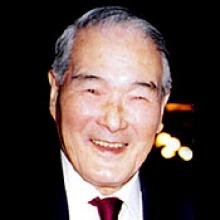
Yoshimaru ABE (1914-2006)
 Born at Fukuoka, Japan on 24 March 1914, he came to Canada 20 April 1927 and settled on Powell Street in Vancouver, before moving to Port Hammond. Yoshimaru left school after eighth grade and joined his father working at a lumber mill.
Born at Fukuoka, Japan on 24 March 1914, he came to Canada 20 April 1927 and settled on Powell Street in Vancouver, before moving to Port Hammond. Yoshimaru left school after eighth grade and joined his father working at a lumber mill.
In 1942, at Port Hammond, he married Yoshi Homma (1918-2013) and they had five children: Kazu Abe, Yumi Abe, Miki Abe, Amy Abe, and Yuri Abe (1951-2011).
During the Second World War, the Government of Canada confiscated property and Japanese Canadians to relocate away from the west coast. Abe was moved to an internment camp near Red Pass Junction, Alberta. He worked building the camp there before he was transferred to Tashme, British Columbia. There he would build another internment camp for approximately 3,000 people before settling as a firefighter.
Following the closing of Tashme, Yoshimaru and Yoshi moved to Winnipeg in April 1947. As a result of his experience working at the Port Hammond sawmill, as well as building the camps at Red Pass Junction and Tashme, he was able to get work building prefabricated homes for Jose Construction. In 1943, Abe launched his construction firm, Fuji Builders, in partnership with Tucker Tanabe, Shigeto Shimoji, and Roy Murata.
Businessman, Writer, Artist, Actor, Community Activist
He was very active in the Japanese Canadian community, serving as a President of the Manitoba Buddhist Temple; helping to create the Japanese Canadian Cultural Center, designing, constructing and maintaining the Japanese garden at the Center, editing the Japanese edition of the Outlook for 50 years, and creating and building the garden and teahouse at the Japanese Pavilion at Folklarama.
In the late 1980s, Abe was involved in the redress campaign, seeking an apology from the Government of Canada for the abuse and mistreatment of Japanese Canadians during the Second World War. He raised awareness of the redress campaign through the Japanese Canadian publication Outlook and speaking rallies. On 22 September 1988, then Prime Minister Brian Mulroney made a formal apology.
Yoshimaru received many prestigious awards for his contributions to community service. He had a great passion for the arts and was a writer, painter, poet, and actor.
He passed away on 09 March 2006 and was buried in Brookside Cemetery.
———————————–
Manitoba Genealogical Society has been transcribing cemeteries since the late 1970s. An abundance of information may be found in these transcripts, including the location of the burial site and information regarding burials where the grave marker is no longer visible. If you would like to purchase a transcript of a Manitoba cemetery, please follow our link.
Sources:
- Obituary [Yoshimaru Abe], Winnipeg Free Press, 11 March 2006, online
- “Yoshimaru Abe”, Winnipeg Architecture Foundation, online
- “Yoshimaru Abe”, Japanese Canadian Artists Directory, online


